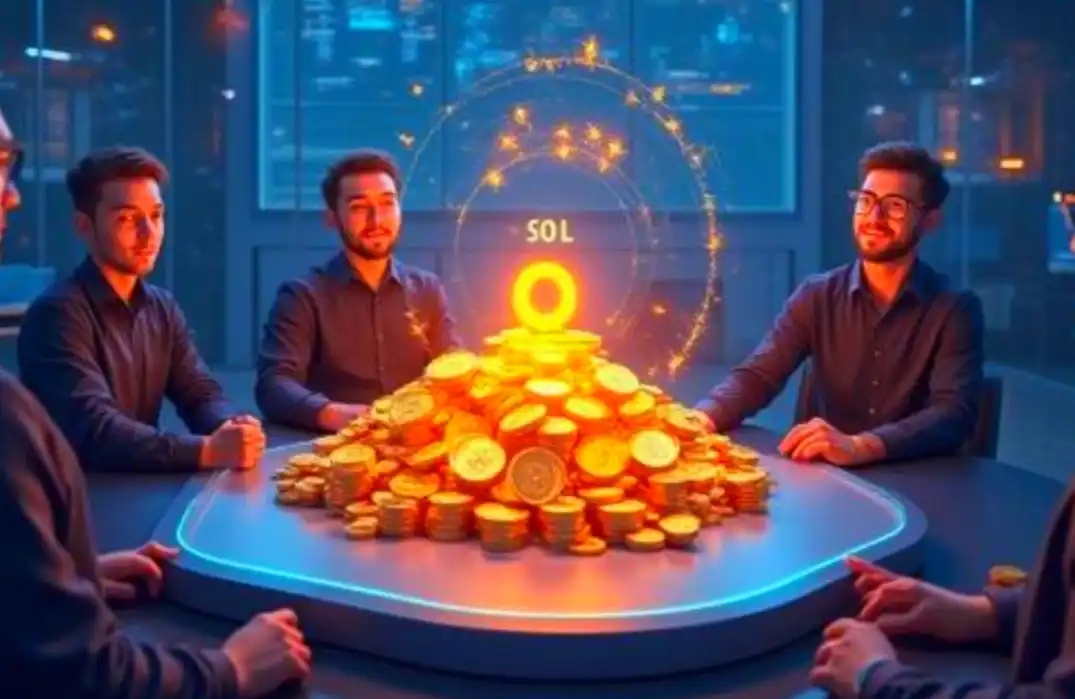Whale Frenzy: How Hot is Plasma's XPL Public Sale?
From WLFI to Pumpfun and now to Plasma, IDO public sales in the bull market are becoming hotter and hotter.
Following Pumpfun's market frenzy, the most recent project to capture the market's attention is Plasma, a new stablecoin-focused blockchain backed by stablecoin giant Tether and Silicon Valley legendary investor Peter Thiel.
In just two short months, this project, which has attracted investments from top-tier capital such as Bitfinex (Tether's parent company), Peter Thiel's Founders Fund, and Framework, has raised nearly $27.5 million, skyrocketing its valuation to $5 billion.
Why has Plasma quickly become the new darling of the market?
Prior to the public sale launch, the Plasma team released a set of rigorous and clear participation rules. Users looking to participate in the XPL public sale must first deposit stablecoins such as USDT, USDC, DAI, or USDS into the official Ethereum mainnet treasury (Plasma Vault).
The earlier and longer you deposit, the more "unit value" your account will accumulate, determining how much XPL you will be able to purchase later.
Therefore, when the governance token XPL quota was released for users to deposit liquidity, the first $500 million quota was snapped up within minutes, and the additional $500 million deposit limit was sold out within 30 minutes. To secure a spot, some whales even paid a $100,000 transaction fee directly on the Ethereum mainnet.
So, what makes Plasma so special?
Plasma's uniqueness lies in using the Bitcoin mainnet as the final settlement layer, inheriting the security of the UTXO model, while fully supporting the Ethereum Virtual Machine (EVM) at the execution layer, ensuring seamless migration of smart contracts.
Most importantly, all transactions on the Plasma chain can be paid directly with USDT for gas fees, with regular USDT transfers being completely free.
In addition to the fee advantage, Plasma also features two important characteristics: first is native privacy features, where on-chain transactions are publicly visible by default, but users can easily opt to hide address and amount information, selectively disclosing it when needed; second is Bitcoin liquidity, as Plasma brings BTC onto the chain through permissionless bridge technology, coupled with Tether's own USD liquidity pool, enabling low slippage exchanges and BTC-collateralized stablecoin borrowing.
How Much Can Plasma Earn in a Year for Tether?
While Plasma provides zero-fee transfers for USDT, it doesn't mean that Plasma has no revenue.
The reason why Plasma dares to claim "USDT transfers are completely free" to users is not because Tether is footing the bill with real money, but because it divides transactions into two billing methods based on complexity and priority. An easy way to understand this is like saying "children under 1.2 meters ride for free."
For regular USDT transfers that use a small block space, similar to "children under 1.2 meters," nodes directly package these transactions into blocks without charging users Gas. However, to prevent spam transactions, Plasma has a basic throughput limit. Additionally, to deter malicious transaction spam, users also need to stake a small amount on-chain, acting as collateral: once the abuse threshold is triggered, this stake will be automatically forfeited. This approach maintains the "free" experience while also blocking junk traffic.
Other requests beyond simple transfers, such as more complex operations like multi-contract calls, batch settlements, institutional-grade instant settlements, etc., are identified by the system and require a fee. The main income of Plasma nodes comes from here, in addition to collecting small fees from cross-chain asset transfers and custody services, giving the entire network self-sustaining capability. Because basic transfers no longer incur fees, the pricing model can be more flexible: based on current on-chain estimates, processing over a thousand free transactions per second consumes minimal resources, and nodes can cover costs and maintain a surplus through a small amount of high-level business.
Supporting this mechanism is Plasma's "dual-layer framework." The underlying layer periodically anchors block states back to Bitcoin, outsourcing security to Bitcoin's proof-of-work; the upper layer directly supports the EVM, allowing developers to easily port Ethereum contracts and run them. Removing traditional Gas calculations actually increases execution efficiency. In a review report, Messari mentioned that Plasma's improved consensus can stably process transactions at the thousand-level payment range with a single-core CPU in stress tests, and node rewards come entirely from those complex transactions.
So how does Plasma make money? The answer is about to be revealed.
First, Enterprise-level "Dedicated Lane"—Cross-border remittance companies or game publishers who want to accelerate transfers from milliseconds to sub-milliseconds must enter the toll lane, paying a fixed USDT monthly fee to ensure bandwidth.
Second, Contracts and Batch Settlements—DeFi protocols that call complex logic still need to pay Gas, but the unit of account changes from ETH to USDT.
Third, Bridging and Custody — Moving assets from other chains to Plasma or redeeming from Plasma incurs a small exit fee, which goes into the Plasma Treasury and is then distributed to nodes and the foundation according to set rules.
Fourth, Governance Token XPL Inflation — Validators stake XPL to receive block rewards, with a portion held in the Plasma Treasury and gradually auctioned over time to sustainably subsidize the 0gas payments for peer-to-peer USDT transactions.
When these four elements are combined, they are sufficient to cover the network's transaction costs for free transfers, and even bring in a new revenue stream for Tether.
If Plasma successfully captures the majority of the USDT traffic currently running on the Tron and Ethereum networks, the initial direct inflow will include a significant portion of the on-chain transaction fees lost to Tron and Ethereum — resulting in an estimated annual income of around $1 billion to $2 billion. With additional revenue from enterprise services and cross-chain fees, the total expected revenue range could reach $1.2 billion to $3 billion. Furthermore, Plasma may have other implicit benefits and ecosystem spill-overs, such as attracting new large liquidity providers and projects, collecting certain "taxes," providing SDKs, facilitating enterprise node access, and charging commercial fees to on-chain applications.
Due to Plasma's free standard USDT transfer fees, it is conservatively estimated that Plasma could generate $1 billion in revenue for Tether annually.
Besides revenue, what's more important is influence. In the past, Tether had to follow the pace set by Ethereum and Tron. If they raised fees or changed rules, USDT could only passively follow suit, and the infrastructure supporting USDT (settlement, execution, bridging, etc.) was largely beyond Tether's control.
Now, Tether is enhancing USDT as a settlement currency, accumulating BTC as reserve assets, and both are converging within Plasma, consolidating the scattered $150 billion USDT across a dozen networks into a unified settlement layer, where transfers, exchanges, and redemptions all occur within Tether's own territory. Tether will also gain more pricing and decision-making power, naturally taking hold of the toll gate for this network layer.
Participation Details of Plasma's XPL Public Sale
As the public sale date approaches, the Plasma team has also released detailed participation rules.
Users participating in the XPL public sale must first deposit stablecoins (USDT, USDC, DAI, or USDS) into the official Ethereum treasury (Plasma Vault). The system will calculate the "unit value" based on the deposit amount and duration for each wallet, which ultimately determines the user's minimum subscription amount. In simple terms, the earlier the deposit and the longer the funds remain, the more XPL a user can ensure to purchase during the public sale.
In order to prevent whale accounts from monopolizing the allocation, the team has set a $50 million deposit cap for each Sonar account, with a maximum of three wallets per account. This means that regardless of the value accumulated across multiple wallets by a user, the total allocation cannot exceed $50 million. Although there is no strict cap on the overall treasury, the team will flexibly adjust the total deposit limit, starting with an initial limit of $100 million and gradually opening up based on market demand to ensure a healthy and balanced distribution.
Furthermore, it is important to note that after the start of the public sale, users will need to submit additional stablecoins in order to actually subscribe to the XPL token. The deposit balance in the treasury will not automatically be used to purchase XPL tokens. If a user does not fully utilize their subscription allocation, the excess allocation will be automatically reallocated proportionally to those who have subscribed beyond their allocation. This means that users can moderately oversubscribe during the purchase to receive additional XPL.
In terms of compliance, all users participating in the public sale must undergo a strict KYC verification on the Sonar platform, including existing Echo account users. U.S. users must provide proof of being an accredited investor, and the XPL tokens subscribed to will be additionally locked up for 12 months after the public sale ends. Users from regions such as the U.K., China, Russia, Cuba, Iran, Syria, North Korea, and Ukraine will not be able to participate in this public sale.
The deposited stablecoin assets will first be exchanged 1:1 to USDT on the Ethereum mainnet by whitelist liquidity providers, then securely transferred to the Plasma network using LayerZero's cross-chain bridge technology and stored as USD₮0. Once the mainnet Beta phase is launched, users can withdraw their principal and all accumulated earnings, with the withdrawal process being transparent and fast, usually taking no more than 48 hours. During this period, the deposit receipt tokens held by users serve as internal vouchers, and any transfer activity will be considered as an early withdrawal. Users are strongly advised by the official team to avoid participating in any DeFi activities using this token.
The treasury facilities used in the Plasma public sale are provided by Veda, which is currently widely used and securely manages over $26 billion in assets. In addition, all contracts have undergone rigorous audits by top security audit firms such as Spearbit and Zellic, and the audit reports will be released before the mainnet Beta goes live to further ensure fund security and transparency.
As the public sale date approaches, excitement is building for this IDO event by Plasma, with most participants believing that Plasma will directly compete with the likes of Solana in the future, becoming the new "king of stablecoin public blockchains," which has generated significant attention for this public sale.
Welcome to join the official BlockBeats community:
Telegram Subscription Group: https://t.me/theblockbeats
Telegram Discussion Group: https://t.me/BlockBeats_App
Official Twitter Account: https://twitter.com/BlockBeatsAsia


 Forum
Forum Finance
Finance
 Specials
Specials
 On-chain Eco
On-chain Eco
 Entry
Entry
 Podcasts
Podcasts
 Activities
Activities
 OPRR
OPRR








